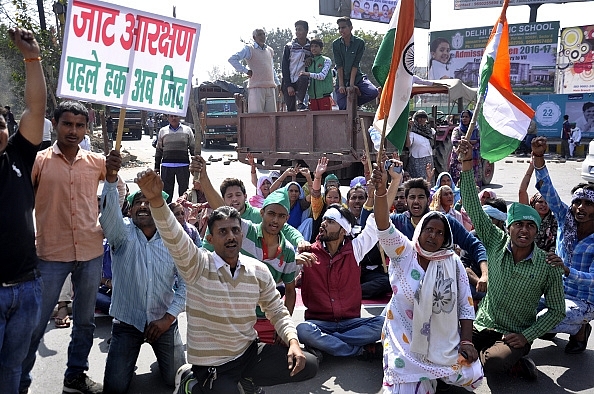Politics
Why Delhi Will Stay Dry For The Next Two Weeks
- Jats have damaged the Munak canal, Delhi’s water lifeline, to such an extent that it will take at least 15 days to restore normal supply.
- While the Army wrested back control of the canal, protesters moved to Khubru, an upstream village, and stopped supply to the canal completely.

Jats protesting to press for their demands for reservations/Getty Images
Keeping nearly 10 million Delhiites fighting for a drop of water is nothing but urban terrorism. Water supply to the national capital is likely to take two more weeks to return to normal levels. Sixteen million people live in Delhi and around three-fifths of the city’s water is supplied by the Munak canal which runs through the neighbouring state of Haryana.
Jats of Haryana, who have close connections with Delhi, economically and emotionally, have damaged the Munak canal. Delhi’s water lifeline has been damaged to such an extent that it will take at least 15 days to restore normal supply.
Both banks of the Munak canal have been completely breached along a length of 250 feet.
Protesters had taken control of Munak canal at Mandora village in Haryana on 19 February. On Monday, the Army finally wrested back control, but protesters moved to Khubru, a village 35 km upstream, and stopped supply to the canal completely.
By Tuesday, authorities hope to supply 475 million gallons per day (MGD), about 50 percent of Delhi’s total supply capacity of 900 MGD.
While the Jats are currently listed as upper caste, the demonstrators have been demanding caste quotas for their community in jobs and educational opportunities – a measure that has been available to lower castes since 1991.
The Wazirabad, Chandrawal and Okhla plants, with a combined capacity of 238 MGD, take raw water from the Yamuna. These plants too are now unable to fully function due to high levels of ammonia in the river.
A Delhi Jal Board team was sent to Mandora to assess the damage to Munak. After the army took control of the canal, Haryana said it would release water through the Delhi sub-branch – an offshoot of Munak – which has a capacity of 215 MGD. However, officials soon realized that despite opening the gates, there was no water in the channel because protesters had blocked the canal in Khubru.
If the canal gates at Khubru are opened, Delhi will get sufficient water to start 50 percent production in the Bawana, Nangloi and Haiderpur plants.
Many Delhiites stocked up on mineral water bottles to tide over the crisis while a section of residents in north Delhi opened their tubewells for use by neighbours.
The army took control of parts of the canal on Monday morning, but repairs are expected to take time.
Delhi Chief Minister Arvind Kejriwal tweeted that the army was “trying to assess in how much time water would reach Delhi and whether any damage had been done to the canal”.
Protesters went on a rampage despite the imposition of a curfew and the deployment of the army, which is reported to have opened fire on them in the districts of Rohtak and Jhajjar.
As jobs have dried up in the private sector and farming incomes have declined, the community has demanded the reinstatement of their backward caste status to enable them to secure government jobs.
Introducing ElectionsHQ + 50 Ground Reports Project
The 2024 elections might seem easy to guess, but there are some important questions that shouldn't be missed.
Do freebies still sway voters? Do people prioritise infrastructure when voting? How will Punjab vote?
The answers to these questions provide great insights into where we, as a country, are headed in the years to come.
Swarajya is starting a project with an aim to do 50 solid ground stories and a smart commentary service on WhatsApp, a one-of-a-kind. We'd love your support during this election season.
Click below to contribute.
Latest